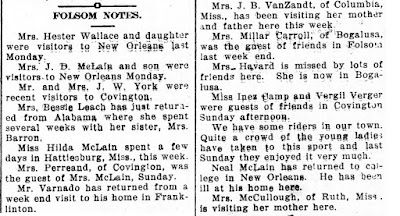On the Banks of Bogue Falaya
by Charles J. Colton (Respectfully inscribed by Miss Lona A Allain)
When I'm tired of the city, when I'm weary of a life,
Spent amid the marts of commerce and the ceaseless push and strife,
When I'd leave it all behind me, all the noises and the beats,
And the constant press and flurry of the busy city streets;
When I'd fain commune with Nature, in her lovliest of moods,
Then I'll hie me to the country, to the balmy piney woods,
Where of joy there is abundance and of trouble there is none,
On the banks of Bogue Falaya, by the town of Covington.
There I'll ramble through the thickets of the alder and the beach,
North the pine trees, south the pine trees,
And the pine trees east and west,
Seeming each to reach to Heaven, with its tall majestic crest,
I will harken to the carols of the birds among the trees.
High up you upon the branches, swaying gently to the breeze,
Or I'll watch the gurgling waters of the river onward run,
On the banks of Bogue Falaya, by the town of Covington.
Yes, whene're my heart is weary and my brain requires rest,
I will pack up my belonging and go eagarly in quest,
Of the land of mingled odors of the pine and violet,
There the world and all its worries for a moment to forget.
And as through the woods I wander, Here and there and everywhere,
Breathing in the balmy incense, Of the early morning air,
I will thank the great Jehovah for the work that he has done,
When he made the Bogue Falaya, by the town of Covington.
Charles Joseph Colton was a New Orleans essayist, poet, journalist, lawyer and court reporter, who was born in 1868 and died in 1916. In 1918, a school located on St. Phillip Street, in the French Quarter, was named after him.
See also:






















































